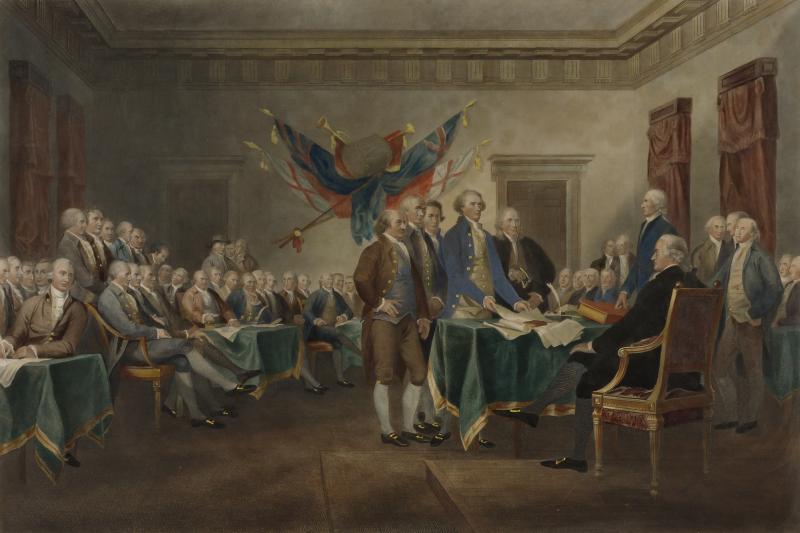A Woman’s Name Appears on the Declaration of Independence: The Story of Mary Katharine Goddard
It’s a well-known fact that 56 men signed their names on the Declaration of Independence, a document that marked a pivotal moment in American history. However, less known is the story of a woman whose name also appeared on this historic document: Mary Katharine Goddard. At a time when women had few rights and limited standing in society, especially in government and business, Goddard’s contributions stand out as a remarkable feat.

Mary Katharine Goddard was living in Baltimore during the American Revolution. Her brother William was the publisher and printer of the revolutionary publication, the Maryland Journal. When William set off traveling during the war, Mary took over the business and continued as the publisher until 1784. Her involvement in the printing of the Declaration of Independence began when the Continental Congress decided to distribute the document throughout the Colonies.
Goddard’s role became crucial when she offered the use of her press to produce the second printing of the Declaration of Independence. This version, known as the “Goddard Broadside,” was the first to include the typeset names of 55 of the 56 signatories. This included notable figures such as Josiah Bartlett, William Whipple, and Matthew Thornton from New Hampshire, and Sam Adams, John Adams, Robert Treat Paine, and Elbridge Gerry from Massachusetts. Delaware representative Thomas McKean’s name was not included as he was late in signing the document after January 1777, when Goddard printed the copies.
A baker’s dozen of the Goddard Broadside was printed in January 1777, and by most counts, nine copies are known to exist today. It was a momentous task, and the inclusion of her full name at the bottom of the broadside—“Baltimore in Maryland: Printed by Mary Katharine Goddard”—was a bold statement of her involvement and contribution.
Goddard’s work went beyond just printing the Declaration. Before producing the Goddard Broadside, she had already made history by being appointed postmaster in Baltimore, becoming the first woman in the Colonies to hold that title. She was responsible for all mail to and from congressional delegates and produced numerous documents for Congress.
In mid-December 1776, with British troops advancing on Philadelphia, the Continental Congress relocated to Baltimore. As postmaster, Goddard managed all communications, and as a printer, she continued to produce vital documents, culminating in the printing of the Declaration of Independence.
The significance of the names included on the Goddard Broadside cannot be overstated. Publishing these names was akin to creating a “most wanted” list for the King of England. The act of printing and distributing these names was a bold declaration of the Colonies’ intent to break free from British rule, risking severe consequences.
John Hancock, who was president of Congress at the time, sent a broadside to each of the states on January 31, 1777, with a letter emphasizing the importance of preserving the memory of this historic event. He wrote: “As there is not a more distinguished Event in the History of America, than the Declaration of her Independence — nor any that in all Probability, will so much excite the Attention of future Ages, it is highly proper that the Memory of that Transaction, together with the Causes that gave Rise to it, should be preserved in the most careful Manner that can be devised. I am therefore commanded by Congress to transmit you the enclosed Copy of the Act of Independence with the List of the several Members of Congress subscribed thereto and to request, that you will cause the same to be put upon Record, that it may henceforth form a Part of the Archives of your State, and remain a lasting Testimony of your approbation of that necessary & important Measure.”
This letter and the broadsides recording this “distinguished Event in the History of America” ensured that Goddard’s name was forever linked to this crucial moment in history. The Declaration of Independence, with its powerful assertion that “all men are created equal” and its outline of the unalienable rights to “Life, Liberty and the pursuit of Happiness,” laid the foundation for the new nation. It was a declaration of the Colonies’ intent to dissolve political bands with Britain and establish themselves as free and independent states.
Mary Katharine Goddard’s contribution to this historic document is a testament to her courage and dedication. Her name, set in type at the bottom of the Goddard Broadside, serves as a reminder of the vital role women played in the American Revolution and the founding of the United States. Her story is an essential part of the history of the Declaration of Independence and the fight for American freedom.

